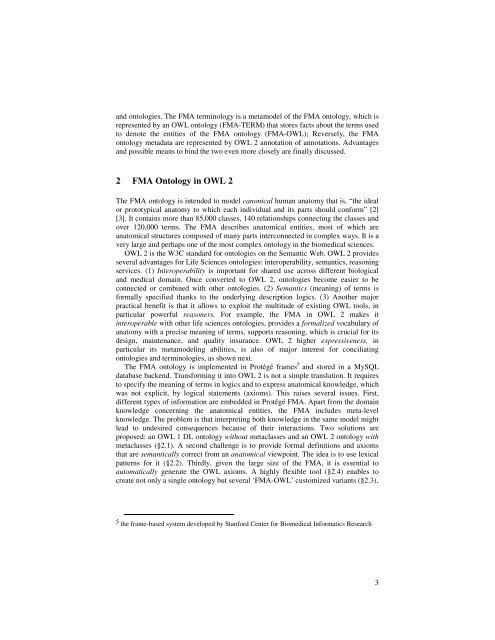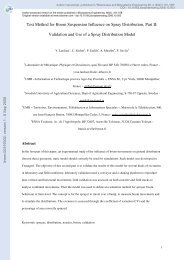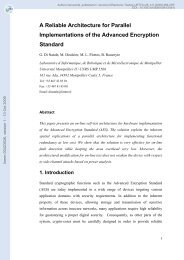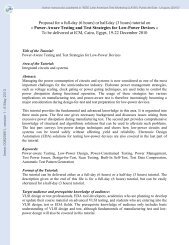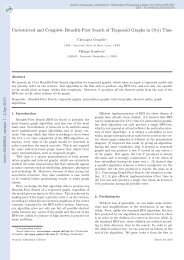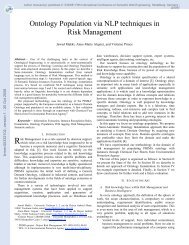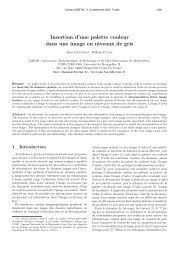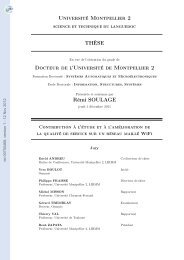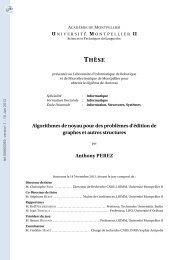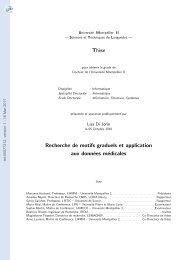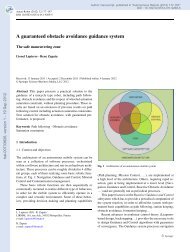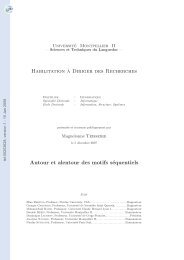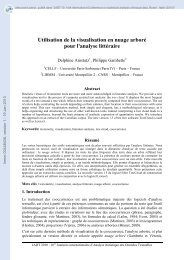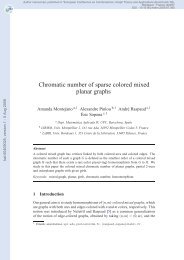FMA & HMTP Portal in OWL - HAL - LIRMM - CNRS
FMA & HMTP Portal in OWL - HAL - LIRMM - CNRS
FMA & HMTP Portal in OWL - HAL - LIRMM - CNRS
You also want an ePaper? Increase the reach of your titles
YUMPU automatically turns print PDFs into web optimized ePapers that Google loves.
and ontologies. The <strong>FMA</strong> term<strong>in</strong>ology is a metamodel of the <strong>FMA</strong> ontology, which is<br />
represented by an <strong>OWL</strong> ontology (<strong>FMA</strong>-TERM) that stores facts about the terms used<br />
to denote the entities of the <strong>FMA</strong> ontology (<strong>FMA</strong>-<strong>OWL</strong>); Reversely, the <strong>FMA</strong><br />
ontology metadata are represented by <strong>OWL</strong> 2 annotation of annotations. Advantages<br />
and possible means to b<strong>in</strong>d the two even more closely are f<strong>in</strong>ally discussed.<br />
2 <strong>FMA</strong> Ontology <strong>in</strong> <strong>OWL</strong> 2<br />
The <strong>FMA</strong> ontology is <strong>in</strong>tended to model canonical human anatomy that is, “the ideal<br />
or prototypical anatomy to which each <strong>in</strong>dividual and its parts should conform” [2]<br />
[3]. It conta<strong>in</strong>s more than 85,000 classes, 140 relationships connect<strong>in</strong>g the classes and<br />
over 120,000 terms. The <strong>FMA</strong> describes anatomical entities, most of which are<br />
anatomical structures composed of many parts <strong>in</strong>terconnected <strong>in</strong> complex ways. It is a<br />
very large and perhaps one of the most complex ontology <strong>in</strong> the biomedical sciences.<br />
<strong>OWL</strong> 2 is the W3C standard for ontologies on the Semantic Web. <strong>OWL</strong> 2 provides<br />
several advantages for Life Sciences ontologies: <strong>in</strong>teroperability, semantics, reason<strong>in</strong>g<br />
services. (1) Interoperability is important for shared use across different biological<br />
and medical doma<strong>in</strong>. Once converted to <strong>OWL</strong> 2, ontologies become easier to be<br />
connected or comb<strong>in</strong>ed with other ontologies. (2) Semantics (mean<strong>in</strong>g) of terms is<br />
formally specified thanks to the underly<strong>in</strong>g description logics. (3) Another major<br />
practical benefit is that it allows to exploit the multitude of exist<strong>in</strong>g <strong>OWL</strong> tools, <strong>in</strong><br />
particular powerful reasoners. For example, the <strong>FMA</strong> <strong>in</strong> <strong>OWL</strong> 2 makes it<br />
<strong>in</strong>teroperable with other life sciences ontologies, provides a formalized vocabulary of<br />
anatomy with a precise mean<strong>in</strong>g of terms, supports reason<strong>in</strong>g, which is crucial for its<br />
design, ma<strong>in</strong>tenance, and quality <strong>in</strong>surance. <strong>OWL</strong> 2 higher expressiveness, <strong>in</strong><br />
particular its metamodel<strong>in</strong>g abilities, is also of major <strong>in</strong>terest for conciliat<strong>in</strong>g<br />
ontologies and term<strong>in</strong>ologies, as shown next.<br />
The <strong>FMA</strong> ontology is implemented <strong>in</strong> Protégé frames 5 and stored <strong>in</strong> a MySQL<br />
database backend. Transform<strong>in</strong>g it <strong>in</strong>to <strong>OWL</strong> 2 is not a simple translation. It requires<br />
to specify the mean<strong>in</strong>g of terms <strong>in</strong> logics and to express anatomical knowledge, which<br />
was not explicit, by logical statements (axioms). This raises several issues. First,<br />
different types of <strong>in</strong>formation are embedded <strong>in</strong> Protégé <strong>FMA</strong>. Apart from the doma<strong>in</strong><br />
knowledge concern<strong>in</strong>g the anatomical entities, the <strong>FMA</strong> <strong>in</strong>cludes meta-level<br />
knowledge. The problem is that <strong>in</strong>terpret<strong>in</strong>g both knowledge <strong>in</strong> the same model might<br />
lead to undesired consequences because of their <strong>in</strong>teractions. Two solutions are<br />
proposed: an <strong>OWL</strong> 1 DL ontology without metaclasses and an <strong>OWL</strong> 2 ontology with<br />
metaclasses (§2.1). A second challenge is to provide formal def<strong>in</strong>itions and axioms<br />
that are semantically correct from an anatomical viewpo<strong>in</strong>t. The idea is to use lexical<br />
patterns for it (§2.2). Thirdly, given the large size of the <strong>FMA</strong>, it is essential to<br />
automatically generate the <strong>OWL</strong> axioms. A highly flexible tool (§2.4) enables to<br />
create not only a s<strong>in</strong>gle ontology but several ‘<strong>FMA</strong>-<strong>OWL</strong>’ customized variants (§2.3).<br />
5 the frame-based system developed by Stanford Center for Biomedical Informatics Research<br />
3


